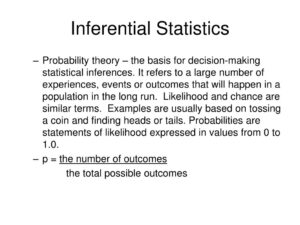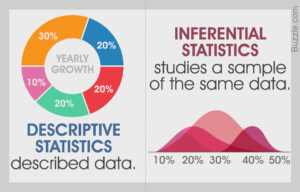
In the ever-evolving landscape of business intelligence (BI), data has become the cornerstone for informed decision-making. With the surge in data availability and complexity, inferential statistics has emerged as a critical tool in shaping strategic choices. This year, as organizations strive to remain competitive, the application of inferential statistics in BI is transforming how decisions are made, providing deeper insights and fostering more accurate predictions. This article explores how inferential statistics is influencing business intelligence and shaping decision-making processes in 2024.
Understanding Inferential Statistics
Inferential statistics involves using data from a sample to make generalizations or predictions about a larger population. Unlike descriptive statistics, which merely summarizes the data at hand, inferential statistics enables businesses to draw conclusions and make forecasts based on data analysis. Techniques such as hypothesis testing, confidence intervals, and regression analysis are fundamental in inferential statistics.
The Role of Inferential Statistics in Business Intelligence
1. Enhancing Predictive Analytics
Predictive analytics is a critical aspect of business intelligence that relies heavily on inferential statistics. By analyzing historical data and identifying patterns, businesses can forecast future trends and behaviors. For instance, regression analysis, a key inferential technique, helps in understanding relationships between variables, such as customer preferences and sales trends. This year, predictive models powered by inferential statistics are being utilized to anticipate market shifts, customer needs, and potential risks more accurately.
2. Improving Decision-Making Accuracy
One of the primary benefits of inferential statistics is its ability to provide more accurate insights by generalizing findings from sample data. In business intelligence, this means that organizations can make data-driven decisions with a higher degree of confidence. For example, confidence intervals offer a range within which a parameter is expected to fall, helping businesses assess the reliability of their estimates. This year, companies are leveraging these insights to refine their strategies, optimize operations, and enhance overall decision-making accuracy.
3. Optimizing Resource Allocation
Resource allocation is a crucial aspect of business management. Inferential statistics assists in determining the optimal distribution of resources by analyzing patterns and trends. For instance, hypothesis testing can help in evaluating the effectiveness of different marketing strategies or operational changes. By applying inferential methods, businesses can make informed decisions about where to allocate resources for maximum impact. This year, organizations are increasingly using these techniques to optimize budgets, improve project outcomes, and enhance operational efficiency.
4. Identifying Market Opportunities
Inferential statistics enables businesses to identify and capitalize on emerging market opportunities. By analyzing sample data and making inferences about broader market trends, companies can uncover new opportunities for growth. For example, businesses can use cluster analysis to segment customers into distinct groups, allowing for targeted marketing strategies. This year, organizations are focusing on leveraging these insights to stay ahead of competitors and explore new markets with greater precision.
5. Enhancing Customer Insights
Understanding customer behavior and preferences is vital for business success. Inferential statistics provides valuable insights into customer demographics, buying patterns, and satisfaction levels. Techniques such as ANOVA (Analysis of Variance) and chi-square tests help in analyzing customer survey data and identifying significant factors influencing customer decisions. In 2024, businesses are utilizing these insights to personalize offerings, improve customer experiences, and build stronger relationships with their target audience.
Trends in Inferential Statistics for Business Intelligence in 2024
1. Integration with Artificial Intelligence (AI)
The integration of inferential statistics with artificial intelligence (AI) is a prominent trend this year. AI-powered analytics platforms are enhancing the capabilities of inferential statistics by automating data analysis, uncovering complex patterns, and providing real-time insights. Machine learning algorithms, for instance, are used to refine predictive models and improve forecasting accuracy. This synergy between inferential statistics and AI is revolutionizing business intelligence and enabling organizations to make smarter decisions.
2. Real-Time Data Analysis
The demand for real-time data analysis is growing as businesses seek to respond quickly to market changes. Inferential statistics is adapting to this trend by incorporating real-time data streams into analytical models. Techniques such as real-time regression analysis and live hypothesis testing are becoming more prevalent, allowing businesses to make immediate, data-driven decisions. This year, the ability to analyze data in real-time is becoming a competitive advantage for organizations across various industries.
3. Increased Focus on Data Privacy
With growing concerns about data privacy and security, businesses are placing greater emphasis on ethical data practices. Inferential statistics is evolving to address these concerns by incorporating privacy-preserving techniques into data analysis. Methods such as differential privacy and secure multi-party computation are being used to ensure that sensitive information is protected while still deriving valuable insights. This year, businesses are prioritizing data privacy in their statistical analyses to build trust with customers and comply with regulatory requirements.
Conclusion
Inferential statistics is playing a pivotal role in shaping decision-making in business intelligence this year. By enhancing predictive analytics, improving decision-making accuracy, optimizing resource allocation, identifying market opportunities, and enhancing customer insights, inferential statistics is driving more informed and strategic choices. As trends such as AI integration, real-time data analysis, and data privacy continue to influence the field, businesses are leveraging these statistical techniques to stay ahead in a competitive landscape. Embracing the power of inferential statistics is crucial for organizations seeking to harness the full potential of their data and make smarter, data-driven decisions in 2024.



